13 Benefits Of Email Marketing You Need To Know
Email marketing is a fantastic digital marketing channel. Email has been around for over 50 years, making it one of the oldest methods of promoting your business.
In this post, we’re covering the core benefits of email marketing. That way, you can finally decide if email marketing is the right strategy to connect with your target audience.
What is email marketing?
As a beginner, email marketing might seem hard at first. Well, nothing can be further from the truth.
Email marketing is the stuff of fourth-graders. Firstly, email marketing involves using email to reach your target audience. It’s as simple as that.
Most email marketing providers offer you many valuable marketing tools that make sending your first email marketing campaign as simple as A, B, and C.
You don’t need technical nous or special knowledge to win at email marketing. It’s one of the many benefits of email marketing and one of the reasons why the strategy beats many other marketing channels.
Provided you have a well-informed email marketing plan, you can send out your first email marketing campaign within the next hour.
And since email marketing is cost-effective and doesn’t attract high costs like many marketing channels, it’s ideal for small businesses with limited marketing dollars.
Why is email marketing important?
Why is email marketing important, and why should small businesses care? First, email campaigns help you to stay in touch with current and potential customers.
Thanks to email, you can nurture new customers down the sales funnel. When the new customers are ready, you can prod them with a final email to close the deal.
On top of that, you can educate potential customers, offering them the information they need to make a purchase decision.
Additionally – and as we will learn later – email helps small businesses like yours to drive traffic, boost brand recognition, conduct surveys, share information, and prepare announcements.
All while delivering the highest ROI of any marketing channel.
Email marketing campaign stats
Here are some stats that show you why every small business owner should care about email marketing:
- Did you know that email has over 4 billion daily users? Yes, that’s right – email is a popular mode of communication. (Statista)
- Email users send a staggering 306+ billion emails per day. (Statista)
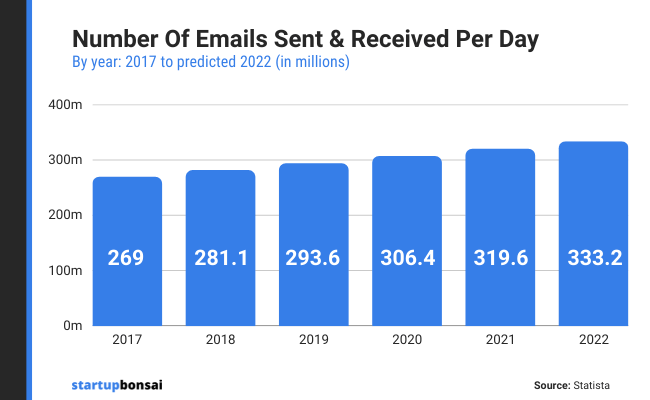
- 99% of email users check their inbox daily. (OptinMonster)
- 64% of small businesses agree they use email as a marketing strategy. (Campaign Monitor)
- 37% of these brands are actively increasing their email marketing budgets. (Litmus)
- Observers estimate that email marketing revenue will reach 11 billion by the end of 2023. (Statista)
- 50% of people buy from promotional emails at least once per month. (SaleCycle)
- 59% of US adults say promotional emails influence their purchase decisions. (SaleCycle)
- The average bounce rate for email campaigns is 9.96% across all industries. (Constant Contact)
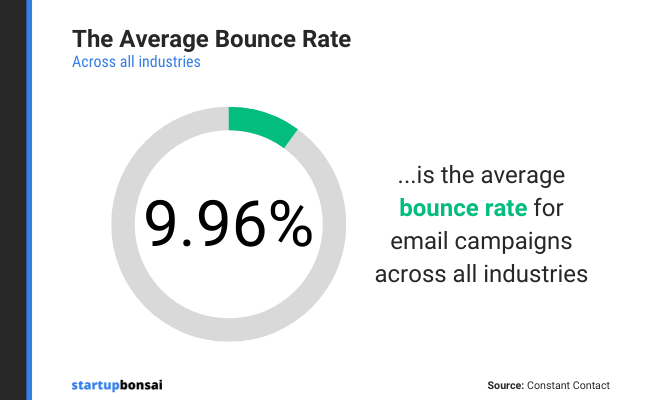
Note: Learn more in our article on email marketing stats.
You will agree that these are impressive numbers. It shows that email marketing works unlike many channels, including Facebook and Twitter combined. Yes, it’s that powerful.
Additionally, many customers love receiving emails from brands they follow. It’s also great news for every small business owner looking to send that first email campaign.
Now you know why sending email campaigns is vital to your marketing strategy. Let’s cover the benefits of email marketing. As we go over the advantages, we’ll also touch on how everything boosts your small business marketing efforts.
Benefits of email marketing campaigns
As you read through the benefits, think of how you can craft an effective email marketing strategy that works for your small business as well as email subscribers. For best results, you should keep the readers’ interests first.
Also, to get the most out of your email marketing efforts, consider personalizing the marketing message, segmenting your email subscribers, and using email marketing software to automate the entire process.
Okay, let us start.
1. Email marketing has high return on investment (ROI)
As a small business with budget constraints, you must make every marketing dollar count. You don’t have the luxury of big enterprises with deep pockets.
Email marketing levels the field. With an impressive ROI of about $36 per every $1 spent, you can expect email marketing to bear fruits. (Litmus)
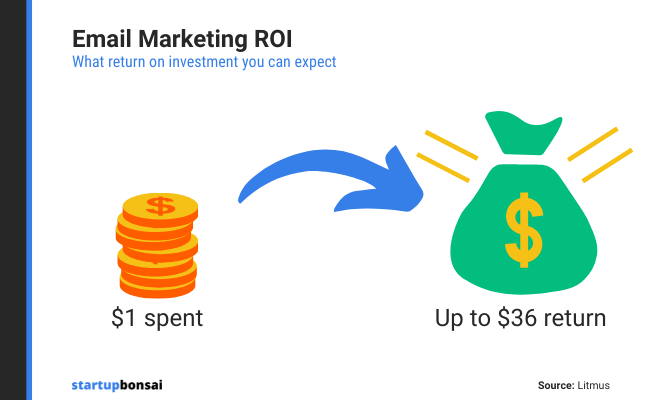
Other digital marketing methods can hardly keep up. Search Engine Optimization (SEO), for instance, is a little above $22 per dollar spent.
Then you have banner ads at $2. Quite interesting, don’t you think? Why do banner ads perform abysmally in terms of ROI?
Perhaps banners lack something email has, as we learn in the next sections.
2. Email marketing personalization
Traditional methods like TV ads, banners, and billboards use what I call a “blast and pray” approach to marketing. In other words, show the ad to many people and hope someone bites.
This is where email marketing has the upper hand. You can segment email subscribers per their preferences. Then send personal marketing newsletters the reader is most likely to love.
The same subject line can mean different things to two different readers. Likewise, the same content may push some readers to click the unsubscribe link.
That’s because people have different needs. Personalize the subject lines and content to maximize open and click-through rates.
Research shows that simply adding the reader’s name in the subject line improves open rates by 50%. The reader is also more likely to click relevant links in the email.
Another application is remarketing. For instance, you can send a specific buyer to upsell a different product or ask for a review. You can also recover abandoned carts by sending personalized emails.
On top of that, you can contact your subscribers individually or you can send emails to their timezones to make each email more personal.
Thanks to personalization, you can easily influence future purchases and so on. The options are endless.
Creating personalized content greatly boosts your leads, conversions, and revenue. God bless artificial intelligence (AI); you can automate the process.
Related Reading: The Best Time To Send Emails For Better Engagement.
3. Use email marketing to drive website traffic
Traffic is the lifeblood of every website. Without traffic, you have no leads, and without leads, you have no sales. Now to you: how do you drive traffic to your website? SEO? Social media?
It doesn’t matter how you drive traffic to your site. Consider adding email marketing to your toolbox. Simply because – when done right – email marketing is a powerful traffic generation technique.
You can send readers to read more content on your website with a single email. This allows readers to discover more of your content and stay in touch with your brand.
On top of that, you can send prospects to personalized landing pages to increase your traffic, hence conversions.
With a solid email marketing strategy, your customers don’t risk missing out on an upcoming product launch and other great deals.
4. Collecting customer feedback
Providing world-class customer service is a fantastic way of adding value and boosting trust. Customers are likely to return for more if you hear them out.
Existing customers are ready to tell you what they think about your business and products. But only if you ask them.
Email marketing is a great tool to collect customer feedback. Periodically send your customer satisfaction surveys, and opinion polls to your buyers.
From the responses, you learn more about your loyal customers and can optimize your product, offering them exactly what they need.
Feedback can also help you improve your customer service, which keeps the customer engaged, ultimately increasing brand reputation and leads.
Prospects and current customers can share their problems via a sign-up form on your site. You just need to add an extra field to your sign-up form. And it works.
I once added an extra input field to my sign-up form asking prospects about their biggest challenge. The results surprised me.
Within no time, I had enough ideas to fine-tune my content – and as you can expect – the new content produced better results.
Adam Connell does something similar over on Blogging Wizard. He sends out an email asking new subscribers what their challenges are:
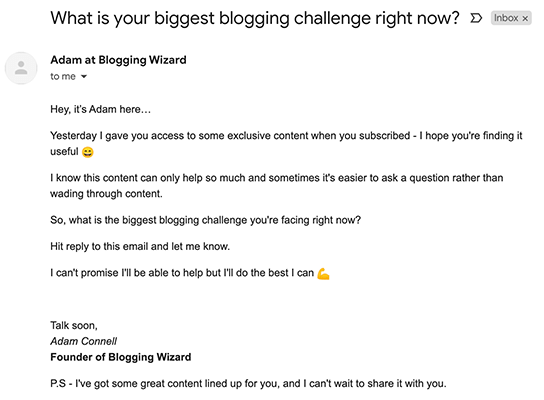
Additionally, the feedback can help you modify future campaigns to align with the needs of your subscribers.
5. Email marketing is cost effective
Like many small business owners, you are probably thinking about email marketing costs. How much does it cost and must you break the bank to send your first email campaign?
Well, no. One of the most obvious benefits of email marketing is the lower cost compared to other marketing methods.
You don’t buy advertising space on billboards or media outlets. In other words, there are no advertising fees, printing, or media costs.
You also don’t need to hire an entire production team – one person on your existing team can curate email newsletters.
Most email marketing providers offer you relatively cheap plans. Nearly all offer a free plan, which is suitable for beginners. You can easily scale as your business grows.
No matter how you look at it, email marketing is way cheaper than most (if not all) marketing methods.
6. Email marketing is easy
Before trying email marketing, I honestly thought it was a tough nut to crack. Perhaps you hold the same notion. Or maybe you’re scared to start because you’re not “tech-savvy” enough.
Let me assure you: email marketing is one of the easiest marketing strategies you’ll ever find. Facebook Ads and SEO can throw you a curveball. But not email marketing.
You don’t need technical know-how to start. Just sign up with one of the many email providers, and you’re good to go.
Many of these providers offer you drag-and-drop editors that make creating email campaigns a breeze. All you do is “point and click” to create professional emails that are optimized for conversions.
7. Email marketing is easily measurable
If you’re spending a ton of money and time marketing, wouldn’t you want to know how many customers are coming in? Of course, you would.
While it’s hard to track the performance of channels such as billboards, TV ads, etc., it’s easy to measure the impact of each email campaign.
Email marketing platforms come with analytics dashboards that offer you metrics such as bounce, open, click-through, and conversion rates.
That way, you can quickly tell the campaign that’s successful. If a campaign fails, you can quickly tell when/where you’re going wrong and fix the problem.
Many other channels are (1) hard to measure and (2) not as flexible when it comes to changes. This is not an issue with email marketing.
8. Email marketing = more engagement
The internet is full of noise. Marketers are doing their best to attract the attention of your prospects.
The competition is stiff, which means you should do everything to keep your audience engaged.
The good thing is email marketing makes engaging your users a lot easier. Firstly, you’re reaching and connecting with an already interested audience.
When subscribers opt into your email list, they are essentially asking to receive your emails. Sending these people relevant content leads to higher conversion rates.
Plus, you have a direct line of communication without distractions that are rife on the internet. You meet the audience where they spend most of their time – their inboxes!
9. Email marketing helps you establish authority
Every marketer will confirm that authority is your online currency. When users identify you as an expert in your niche, they are more likely to trust and buy from your brand.
The astute email marketer uses the resources at their disposal to establish authority. To build credibility, start by sharing valuable content with your readers.
If a reader finds your content useful, they are more likely to sign up for your email newsletters to read more great content.
After that, you can develop the customer relationship with more emails and lead them down your sales funnel.
Don’t forget to share valuable content in your emails. Add lots of helpful tips to provide more value, and increase brand awareness.
If you run your own business, it’s easier to guide prospects through the customer journey if they see you as an authority in the industry.
10. Increase sales
As we saw earlier, 59% of consumers agree that marketing emails influence their purchase decision. Also, 50% of people say that they buy from promotional emails at least once a month.
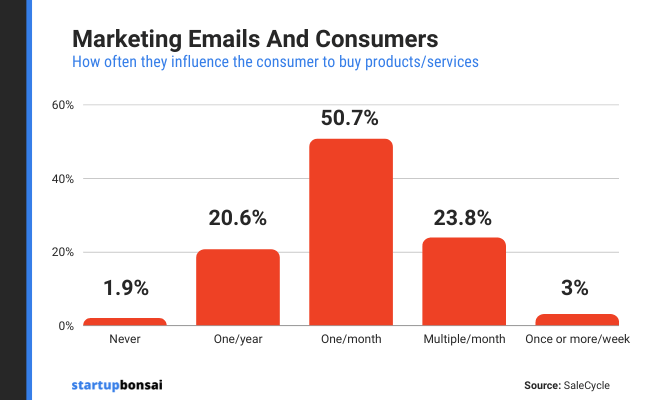
You can incorporate promotional messages and offers to encourage purchases from an audience that is already interested in what you’re offering (seeing as they opted in).
Additionally, including your products in your emails gives your target audience the chance to buy right inside their inboxes, even when they are using mobile devices.
This is a great way of taking advantage of impulse buying. You also have the chance to use other psychological tricks to boost sales.
11. Email marketing improves SEO
As we’ve already seen, SEO is not as good as email as far as ROI goes. While email in itself is not a Google ranking factor, you can use well-planned campaigns to boost your search rankings.
We already know email is one of the most valuable marketing tools to drive a lot of relevant traffic to your site, especially if you have a huge mailing list.
Sending lots of qualified traffic to your site can benefit your organic search rankings indirectly.
Here’s why:
Email subscribers are typically highly engaged. They’re more likely to comment, share on social media, and even link to your content.
Social signals help your content get indexed faster, and can lead to earning links. And some of your subscribers may link to your content directly.
The further your content reaches, the more chance you’ll earn backlinks to your content.
12. Email is shareable
Are you familiar with the concept of viral email marketing? If not, it’s a strategy that involves crafting emails that readers share with many people within a short period.
It’s an effective marketing strategy that big-name brands such as Virgin Atlantic and Google use.
Your subscribers can share great deals with friends, quickly getting your brand and offers in front of more people.
And do you know what? People are more likely to buy via referrals from trusted friends. Viral emails will boost brand awareness within a short period.
13. Email can take many different forms
Email offers you multiple ways to achieve your marketing goals. You can create different emails to meet prospects at specific steps of your buying funnel.
Each type of email comes with its unique benefits, which means you can easily optimize your strategy and qualify leads without wasting resources.
You can send different types of emails: welcome, thank-you, newsletters, offers, and lead-nurturing emails to connect with prospects at the stage they are most likely to engage.
That way, you can effectively boost your open, engagement, and eventually conversion rates, allowing you to get the most out of your campaign.
Fun facts
- Computer engineer Ray Tomlison sent the first email in 1971, starting a new era in digital communications. He is also the guy who introduced the “@” symbol in email addresses.
- In 1978, Gary Thuerk, then the marketing manager at Digital Equipment Corp, sent the first commercial email to 400 addresses, resulting in about %13 million in sales. He is infamously known as the “Father of SPAM.”
- Offering business treats and free stuff in your emails will improve your results. For instance, Starbucks offers their gold members free drinks over the holidays. This builds excitement and makes customers feel like a part of something, which is yet another benefit of email. Giving free stuff in your emails works wonders.
- If your business targets the right person via email personalization, you can boost your open rates by over 50%.
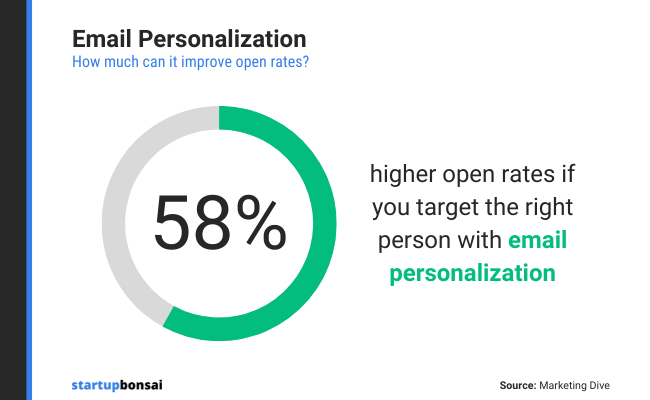
- Email is one of the cheapest ways to do online marketing.
- The average bounce rate for email is 9.96% for all industries. The bounce rate for social media marketing is 50%. Print and display ads have a bounce rate ranging from 50% to 90%.
Best practices
- Don’t spam – Nowadays, there are huge fines associated with data privacy violations, so avoid buying unqualified email lists. Also, your emails will end up in the spam folder. You’re better off growing your mailing list naturally using lead magnets.
- Practice good mailing list hygiene – Remove incorrect emails and inactive subscribers to protect your sender’s reputation with popular email services, such as Gmail.
- Send campaigns regularly – Otherwise, your readers will forget you and probably unsubscribe.
- Stay focused – Each campaign should focus on a single marketing objective or you will confuse your audience.
- Track, track, track – Don’t send an email and sit back, monitor the performance of every campaign and adjust to achieve your results. Key performance indicators (KPIs) to track include open, click-through, and unsubscribe rates as well as traffic and sales.
- Have a conversation with your audience – Aim to build rapport first. Don’t jam your message down their throats in hopes of making a sale. Develop a sound email strategy first.
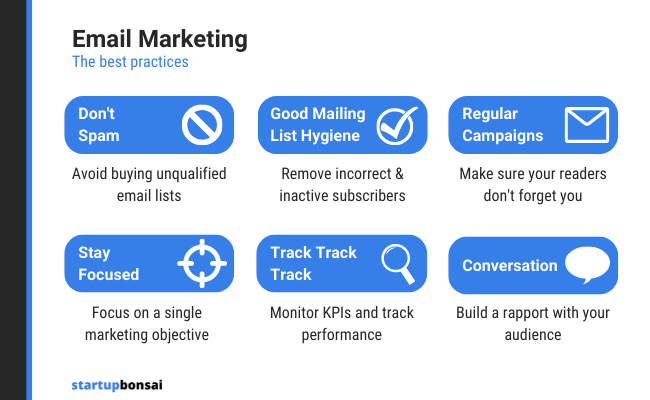
Popular email marketing software
Here is a quick list of popular email software to help you hit the ground running.
Final words
Email marketing is without a doubt a powerful marketing avenue for all types of businesses – big or small. The benefits far outweigh the cons, and the ROI is unrivaled.
Is your business taking advantage of email marketing? If not, what are you waiting for? It’s affordable and easy to start.
There’s no reason not to. It’s easier than ever to find reliable email marketing programs. And there are plenty of resources on the web to help you create high-impact email marketing campaigns.
